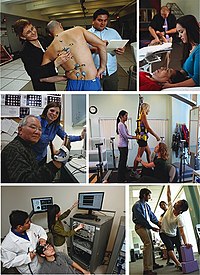
Photo from wikipedia
Diseases of joints are often associated with the alterations in the function of the associated muscles. The pathophysiological mechanisms underlying these changes in the muscle functions are poorly understood, however.… Click to show full abstract
Diseases of joints are often associated with the alterations in the function of the associated muscles. The pathophysiological mechanisms underlying these changes in the muscle functions are poorly understood, however. Here, we explored the alterations in the neuromotor status of the hip quadriceps muscles in the coxartrosis and gonartrosis patients using electrostimulation myography. We found elevated motor response and H-reflex thresholds and a decrease of their amplitudes in the coxarthrosis and gonarthrosis patients compared to the healthy subjects. While the alterations in the motor responses may result from the reduced blood supply of the joint and the femoral nerve, changes in H-reflex indicate an involvement of the nociceptive signals from the joint in the central mechanisms of the movement control. We suggest that reduced reflex excitability of the spinal cord motor neurons controlling the quadriceps muscle in the coxartrosis and gonartrosis patients involves the afferents from the flexors and/or presynaptic inhibition of the IA afferents.
Journal Title: BioNanoScience
Year Published: 2017
Link to full text (if available)
Share on Social Media: Sign Up to like & get
recommendations!